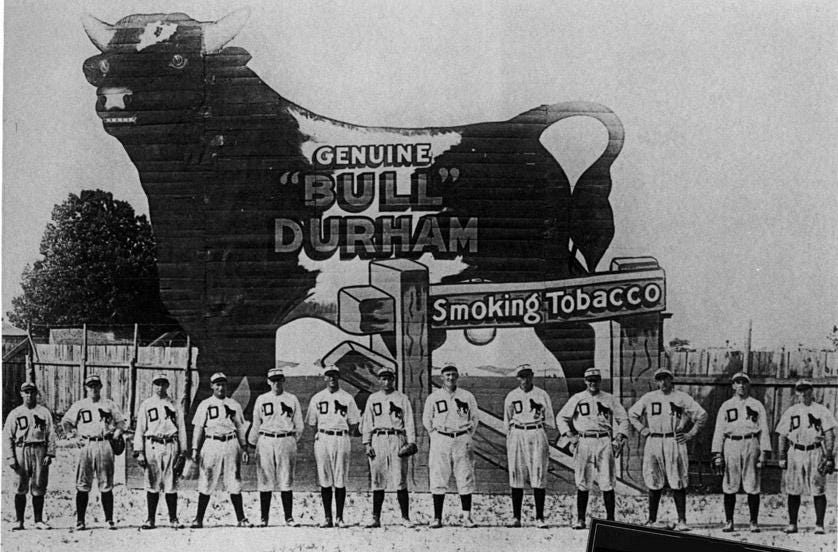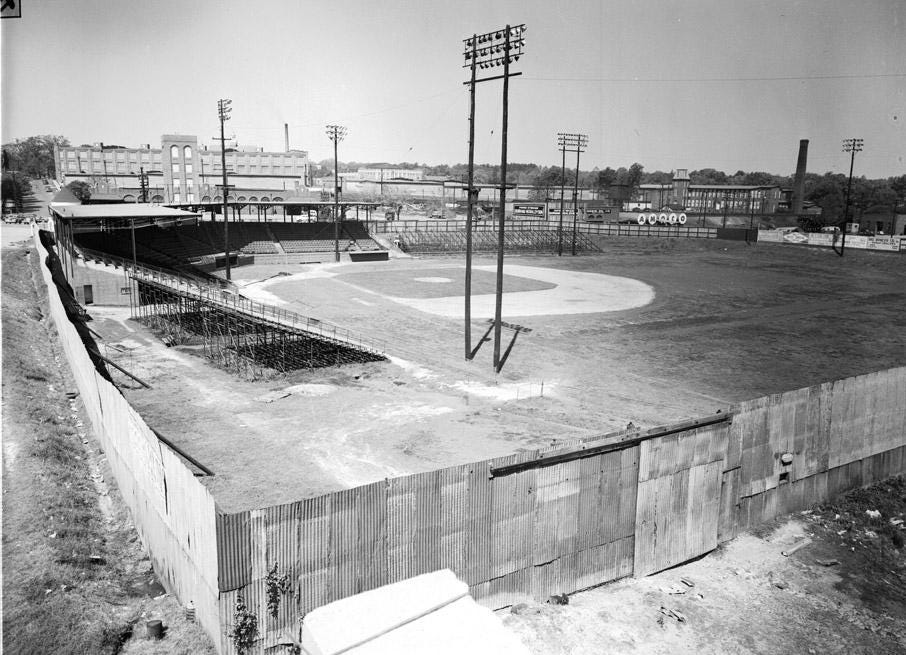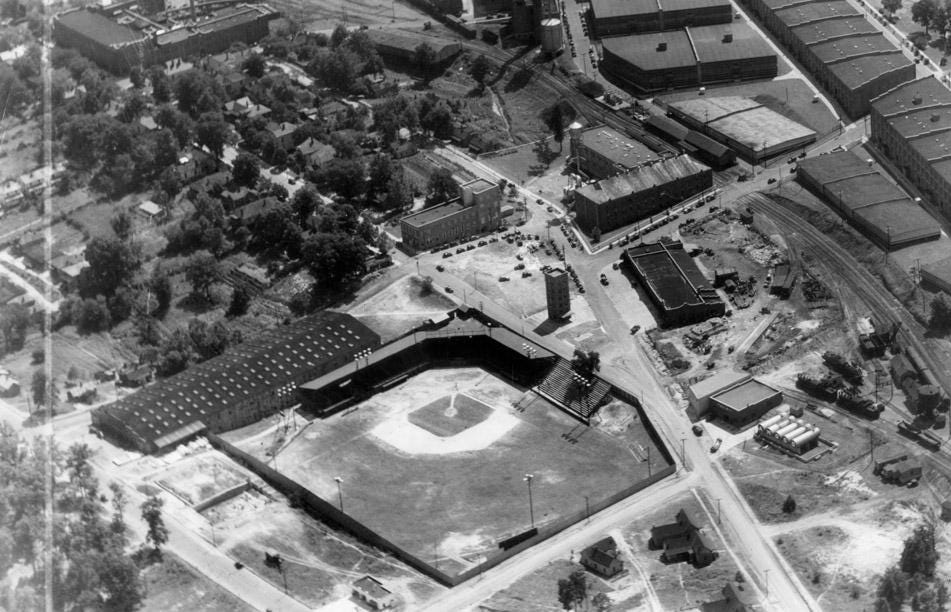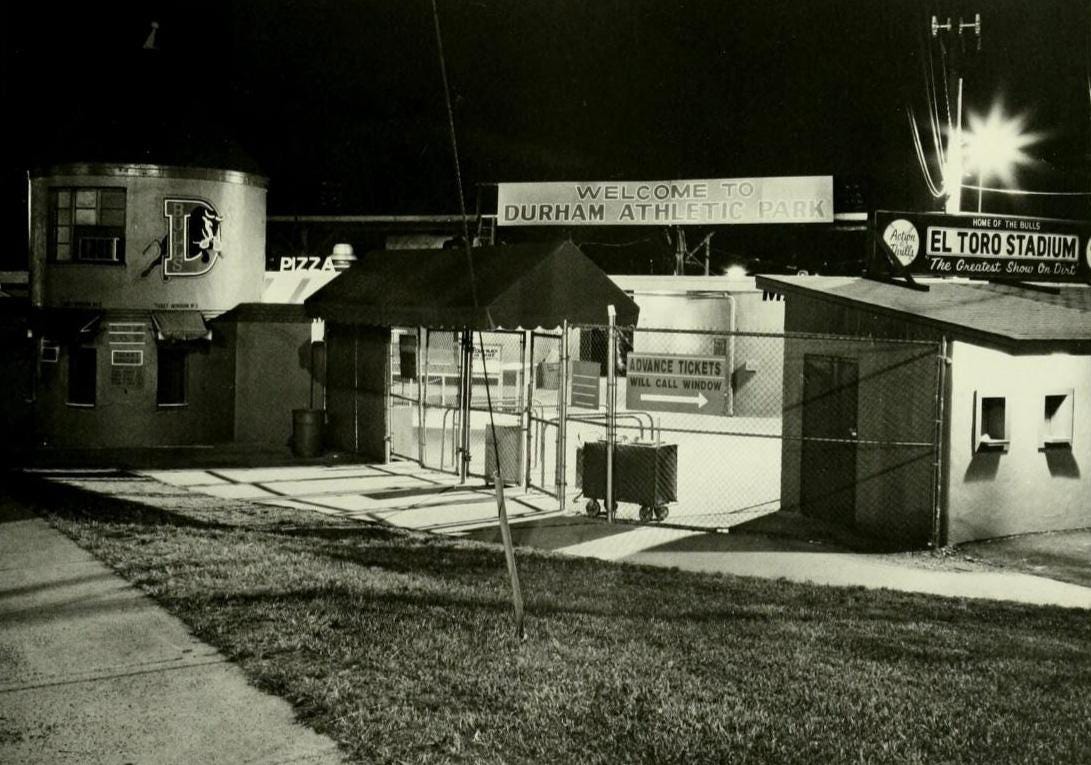The Old Ballpark Still Matters
Durham Athletic Park represents the soul of its city, and is deserving of an ambitious second act.
This is Part I of a series on Baseball and placemaking, focused on the history and redevelopment of the Durham Athletic Park.

"I believe in the Church of Baseball." – Annie Savoy, Bull Durham
There are few places in Durham where the past and present sit so closely side by side as they do at the Durham Athletic Park (DAP). Built almost a century ago at the Northeast corner of Corporation and Washington, it was immortalized in the 1988 film Bull Durham. Ever since, the DAP has been more than just a ballpark—it's one of the city's most enduring landmarks.
Located at the northern edge of the city's iconic Durham.ID tobacco warehouses and steps from the gritty adaptive re-use of the DIY/NorCo district, the DAP is a reminder of Durham's ever-evolving identity.
As the city weighs potential changes to the park, big questions loom: What is the highest and best use for this land? And can we preserve the DAP’s spirit while meeting modern needs?
A Cultural Anchor
Long before the skyline of new apartments, restaurants, and tech offices filled downtown, the DAP stood as a civic anchor. Originally constructed in 1926 as El Toro Park and rebuilt in 1939 after a fire, the ballpark was designed by local architect George Watts Carr. From 1926 to 1994, it served as the home of the Durham Bulls, cultivating generations of baseball fans and community memories.
The park's cultural significance exploded onto the national stage with the release of Bull Durham. In the film, Kevin Costner's Crash Davis delivers his now-famous monologue, equating the rhythm of baseball with a belief system, a lifestyle, a truth.
Many consider Bull Durham the greatest sports film of all time. It captures the religiosity about the game and the people who live for it. The DAP—not a movie set, but a real stadium—offered a backdrop so authentic it practically stole the show. In the late 1980s, few things felt more American.
A Place for More Than Baseball
While the Bulls moved to their new Durham Bulls Athletic Park (DBAP) stadium in 1995, the DAP never stopped being a place of community gathering. It has remained active through college and high school use. Following the move, in 1998 the Bulls transitioned from Class-A to Triple-A classification which coincided with them becoming the affiliate of newly formed Tampa Bay Devil Rays (now Tampa Bay Rays).

In recent years, the DAP has continued to evolve as a community space. It has hosted concerts like Sylvan Esso, beer festivals, and the Bull Durham Blues Festival. The Long Ball Program runs a teen summer league there, fostering tradition and equity through baseball. In earlier decades, it even doubled as a football stadium for Durham High School, now Durham School of the Arts.
The Question: What Now?
Today, as the ballpark enters its second century, the city of Durham is asking itself to question the highest and best use of the ballpark.
In 2024, a feasibility study led by design firm Perkins & Will was commissioned to evaluate how the DAP could evolve. While it is pending presentation, the scope of the project is ambitious: identify improvements that meet the needs of the present while honoring a near-century of history.
What complicates the question is that "highest and best use" isn’t just about square footage, revenue potential, or development opportunity. It’s also qualitative. How do you measure place-based memory? Or cultural significance? Or pride? Or the emotional irrationality that baseball represents and the movie so eloquently captured?
Memory as Infrastructure
Despite its wear-and-tear and its lack of headline purpose, the DAP remains a critical part of Durham, not just because of what has happened there, but because of how it makes people feel. In the post-industrial cities of the South, where rapid change often leads to erasure, memory functions as a kind of infrastructure. It reminds us of what matters. And, in doing so, it can guide us to better decision-making.
To let the DAP become a relic—or worse, a hollowed-out token of the past—would be to miss the point. The park doesn’t need reinvention. It needs recommitment. Not just from the government and developers, but from the people who believe in the church of baseball, and who believe in Durham.
Preserving the Durham Athletic Park isn’t about nostalgia. It’s about recognizing that some places matter not just for what they are, but for what they represent.
This is Part I of a three-part series. In forthcoming publications, Part 2 will discuss current uses of the park, and Part 3 will explore how the city can utilize the facility to help Durham flourish.
Levent Goknar is the James Hardie Fellow for Urban Development. He is a Durham native and student at the University of Wisconsin-Madison.







The Durham Athletic Park (DAP) is the most famous minor league baseball stadium in the world.
I am so excited for this series, which posits what the city should do with the property and how to manage it so it thrives in its second century.